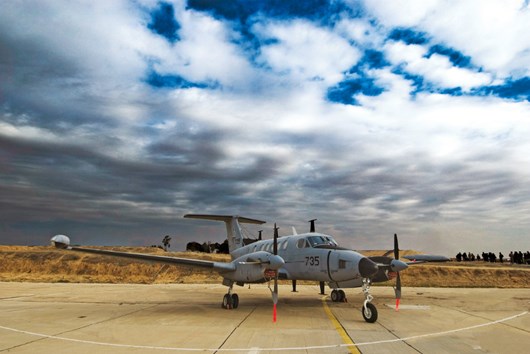How the IDF Gets Real-Time Intel to Abort Strikes
During Operation Protective Edge, planes from the Flying Camel Squadron flew over their targets before conducting an aerial strike. The pilots of these planes decided whether to hit the target or to cancel the strike if they believed it would endanger the civilians.

Lt. Col. Y, the Flying Camel Squadron’s commander, defines his squadron’s job: “We don’t have bombs on our planes. We have cameras that do intelligence work and our job is to make sure that the bombs hit the right targets and only the right targets.” The right targets are Hamas and other terrorist organization sites in the Gaza Strip, which are often located near or in civilian infrastructure.
Working Against Hamas’ Civilian Shield Policy
Hamas embedded its military deep into the civilian infrastructure of Gaza, making the job of the Flying Camel Squadron of the utmost importance.
“Most of the rocket launchers we detected came from highly populated areas, near houses or in school yards,” says Lt. Col. Y. “A lot of Hamas infrastructure is underground. They fire from pits and tunnels. We know this because after we’d hit the coordinate, we would see the underground infrastructure. We saw the tunnels, we saw the openings, the hidden ammunition, etc. Sometimes it can be very close to a house so the attack needs to be very accurate.”
Hamas spared no civilian buildings when embedding its military. The IDF, under the direction of the Flying Camel Squadron, had to make tough decisions when Hamas terrorists abused places such as hospitals and schools.
“Sometimes it’s very frustrating because you actually see rockets being launched from mosques, schoolyards, from places you can’t attack and a lot of time, it’s from the vicinity of these facilities. When it’s nearby, we try to clear the place. If the situation is unclear, the attack will be aborted. Maybe we would return to strike the target at a different time or maybe not hit the site at all.”
“This is the responsibility that our crews has to deal with everyday,” says Lt. Col. “It's not easy during battle, because you sabotage your operational achievement. Nevertheless, we do it because we believe it's important.”
The IDF Trains to Prevent Civilian Casualties
Cpt. O, an operations officer and a pilot in the squadron, declared that, “for us, the death of any civilian, whether Palestinian or Israeli, is tragic.”
He emphasized, “As a person, hearing about children being killed is heartbreaking and that’s understandable for everyone. The IDF puts a lot of time, money, and effort into training us to prevent civilian casualties.”
“We face an enemy who puts its civilians in the middle of the conflict. The IDF keeps emphasizing the fact that we will attack and fight military targets – ammunition shelters, rocket launchers, and drone facilities, etc. On the other side, Hamas indiscriminately fires rockets at whatever it can. We pinpoint targets as much as we can and we bomb areas where we know for a fact they are used to attack Israeli civilians,” concluded Cpt. O.
The History of the Flying Camel Squadron
The Flying Camel Squadron has operated since the establishment of the IDF and has participated in all of Israel’s wars. It has 2 kinds of planes- the Bonanza and the Tzufit (“sunbird” in Hebrew).

The Tzofit (Beechcraft King Air) flies as an important component of the light transport system for gathering close and long distance intelligence.
“Our mission is information gathering,” say Lt. Col. Y. “We have the capability to work together with air and ground forces to counter terrorism and minimize casualties of innocent civilians. We use our capabilities to guide our soldiers to the right targets and all aerial reconscience.” The squadron’s optical equipment is all Israeli made and is some of the most advanced equipment there is today.

